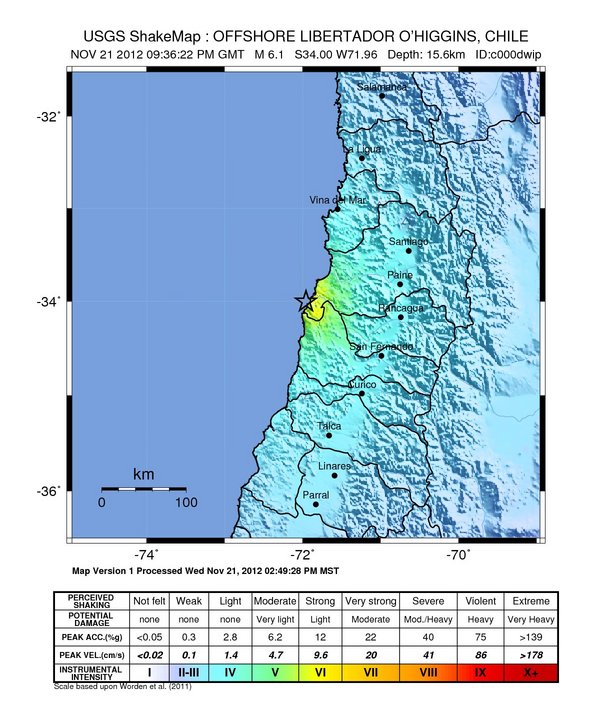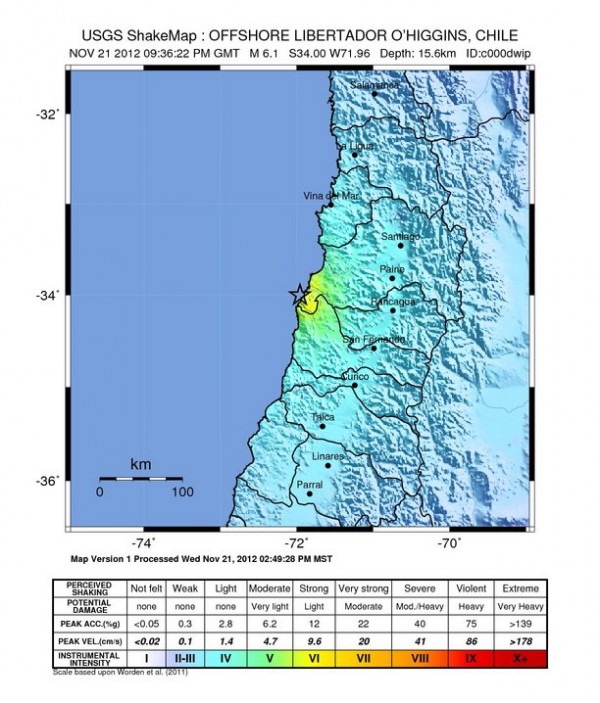Magnitude 5.9 earthquake struck offshore Libertador O’Higgins, Chile

Strong earthquake measuring M 5.9 struck offshore Libertador O’Higgins, Chile at 21:36:22 UTC, November 21, 2012 according to USGS. The epicenter was located 106 km (66 miles) SSW (195 degrees) of Valparaiso and 132 km (82 miles) WSW (245 degrees) of Santiago, Chile at depth of 15.6 km (9.7 miles). Universidad de Chile reports preliminary values of M 6.1 at 1 km depth. EMSC reported initially M 6.1 at depth of 5 km, but revised to M 5.9 later. USGS preliminary report also said M 6.1 and was revised to M 5.9.
| Magnitude | 5.9 |
|---|---|
| Date-Time |
|
| Location | 34.016°S, 72.017°W |
| Depth | 15.7 km (9.8 miles) |
| Region | OFFSHORE LIBERTADOR O’HIGGINS, CHILE |
| Distances | 54 km (33 miles) SW of San Antonio, Chile 59 km (36 miles) SSW of Cartagena, Chile 76 km (47 miles) WSW of Melipilla, Chile 88 km (54 miles) NW of Santa Cruz, Chile |
| Location Uncertainty | horizontal +/- 14.2 km (8.8 miles); depth +/- 3.4 km (2.1 miles) |
| Parameters | NST=494, Nph=508, Dmin=110.2 km, Rmss=0.99 sec, Gp= 32°, M-type=(unknown type), Version=B |
| Source |
|
| Event ID | usc000dwip |
This is second strong earthquake today in the same area. Earlier today at 18:16:36 UTC, magnitude 5.1 earthquake occurred with epicenter 62 km (38 miles) SW of San Antonio at depth of 9.7 km (6.0 miles).
Tectonic Summary by USGS
Seismotectonics of South America (Nazca Plate Region)
The South American arc extends over 7,000 km, from the Chilean margin triple junction offshore of southern Chile to its intersection with the Panama fracture zone, offshore of the southern coast of Panama in Central America. It marks the plate boundary between the subducting Nazca plate and the South America plate, where the oceanic crust and lithosphere of the Nazca plate begin their descent into the mantle beneath South America. The convergence associated with this subduction process is responsible for the uplift of the Andes Mountains, and for the active volcanic chain present along much of this deformation front. Relative to a fixed South America plate, the Nazca plate moves slightly north of eastwards at a rate varying from approximately 80 mm/yr in the south to approximately 65 mm/yr in the north. Although the rate of subduction varies little along the entire arc, there are complex changes in the geologic processes along the subduction zone that dramatically influence volcanic activity, crustal deformation, earthquake generation and occurrence all along the western edge of South America.
Most of the large earthquakes in South America are constrained to shallow depths of 0 to 70 km resulting from both crustal and interplate deformation. Crustal earthquakes result from deformation and mountain building in the overriding South America plate and generate earthquakes as deep as approximately 50 km. Interplate earthquakes occur due to slip along the dipping interface between the Nazca and the South American plates. Interplate earthquakes in this region are frequent and often large, and occur between the depths of approximately 10 and 60 km. Since 1900, numerous magnitude 8 or larger earthquakes have occurred on this subduction zone interface that were followed by devastating tsunamis, including the 1960 M9.5 earthquake in southern Chile, the largest instrumentally recorded earthquake in the world. Other notable shallow tsunami-generating earthquakes include the 1906 M8.5 earthquake near Esmeraldas, Ecuador, the 1922 M8.5 earthquake near Coquimbo, Chile, the 2001 M8.4 Arequipa, Peru earthquake, the 2007 M8.0 earthquake near Pisco, Peru, and the 2010 M8.8 Maule, Chile earthquake located just north of the 1960 event (Read more here).
Featured image: USGS Shake Map


[…] The Watchers – Magnitude 6.1 earthquake struck offshore Libertador O’Higgins, Chile. Tagged with: danger If you enjoyed this article, please consider sharing […]